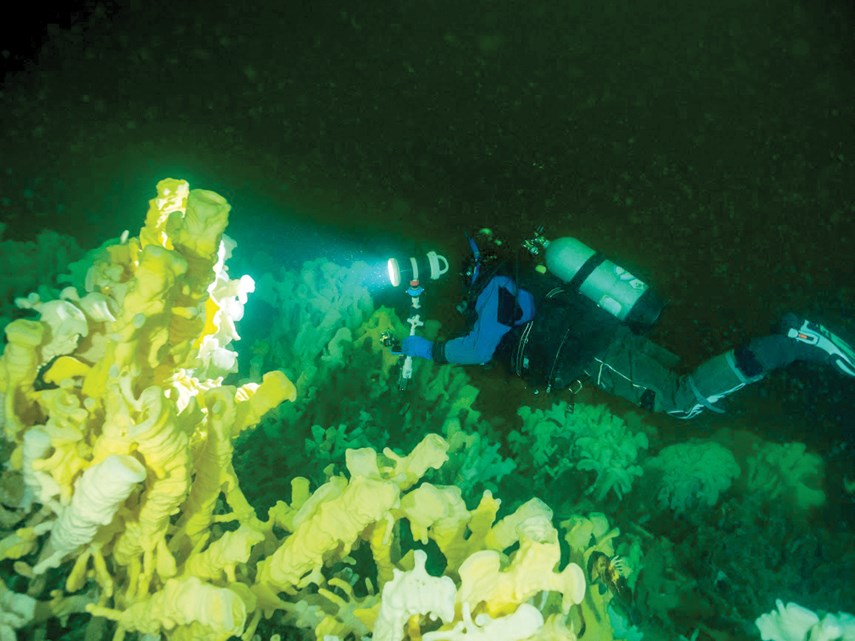The sweet spot is about 250 feet below sea level.
In the depths of Howe Sound, herring and anchovy flit out of the swirling darkness and briefly turn iridescent in the light of Glen Dennison’s custom-made video camera.
Amid all that darkness, Dennison is looking for glass sponge reefs.
“It’s actually pretty amazing when you find one of these things,” he says. “You’ll be looking at a very dark bottom and all of a sudden it goes bright white.”
Dennison, a director with North Vancouver’s Marine Life Sanctuaries Society, helped discover 13 additional glass sponge reefs in Howe Sound.
Thought to have gone extinct 37 million years before humans fashioned stone tools, the glass sponge reefs are alive and well in Howe Sound, and Dennison is determined to make sure they stay that way.
Fisheries and Oceans Canada recently requested anyone fishing for prawns, shrimp, crab and groundfish avoid sections of Howe Sound to protect the newly discovered glass sponge reefs. That’s in addition to fishery closures put in place in 2015 to protect nine sponge reefs from crab traps, shrimp trawlers, and other bottom contact fishing gear.
While a final report from the department is pending, the reefs are “biologically significant enough” to warrant a precautionary approach, according to a DFO release. Further study and consultation with First Nations and other groups is scheduled for this winter.
That release credited North Vancouver’s Marine Life Sanctuaries Society for the discovery of the reefs, much to the delight of MLSS director Adam Taylor.
“It was citizen science efforts that put them on the map,” Taylor said of the 13 previously undiscovered reefs.
MLSS was essentially able to pinpoint the reef locations, allowing DFO crews to head on the water and head straight for the reef.
“We eventually saved them years and a whole lot of money,” he said.
But while DFO’s voluntary prohibition is gratifying, there’s still a concern around enforcement, according to Taylor.
“To a certain extent it’s actually painting a target on them,” he said, suggesting some people may target the areas for fishing.
Part of the problem is the reefs can be prime fishing areas for prawns, leading to traps that can destroy the reefs which provide a crucial habitat for those same prawns, explained Sabine Jessen, oceans program director for the B.C. chapter of the Canadian Parks and Wilderness Society.
“If we want to have prawns into the future we’ve really got to protect habitats like these,” she said.
The sponges have a consistency similar to meringue, Jessen noted.
“The sponges themselves are so fragile that anything really heavy that touches them causes them to just disintegrate and break off,” she says. “We do see damage when we go and take a look.”
However, Taylor said he has seen DFO crews pulling up illegal traps. He’s also been encouraged by several municipal governments speaking up about what is sometimes treated as a strictly federal issue, he noted.
“People involved in documenting these sponge reefs care about what is located in our backyard,” he stated, noting that while he lives in Vancouver, he’s a fourth-generation Bowen Islander with roots on the island dating back to 1895.
It’s imperative the reefs are protected, according to Taylor, who noted Howe Sound may be the only place in the world where, “you can just go for a scuba dive” on the reefs.
Dennison agreed, explaining that he’s used high-resolution mapping and a drop camera “that’ll go right down to the bottom of Howe Sound,” and scuba diving to find the reefs.
With the help of students and fellow volunteers, MLSS would map the area and check the topography, looking for rocky pinnacles. If the bottom of the sound was 150 feet or shallower, Dennison would scuba dive. In deeper water, he’d deploy the camera.
Most of the discoveries were made on the east side of Howe Sound, running in an almost straight line from Passage Island, Dennison says.
The sponges were immediately apparent as glowing orange, yellow or white reefs with three-metre crowns contrasted with the sound’s turbidity.
Their abundance in Howe Sound may have to do with high silica levels related to glaciers butting against each other and slowly chipping away at granite deposits.
The reefs provide hiding places for rockfish and filter large amounts of bacteria. However, despite the fact that the reefs may date back to the Paleozoic era, there’s still much to learn.
“The initiative is very important for reasons we may not even understand at this point,” Dennison said.
Taylor agrees, likening the reefs to crocodiles, sharks, and horseshoe crabs.
“If something’s still around after hundreds and hundreds of millions of years, it hasn’t been out-competed, it’s got to be doing something right.”



